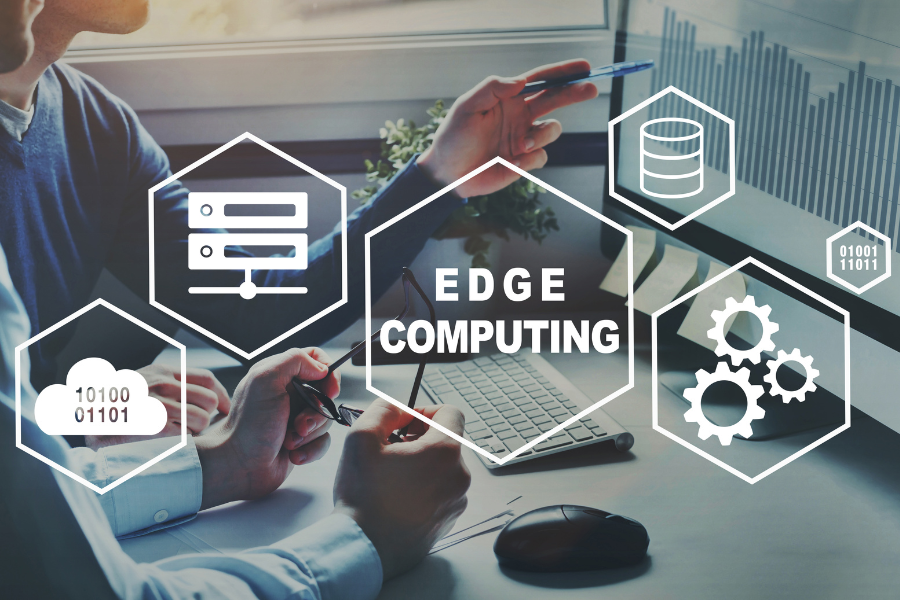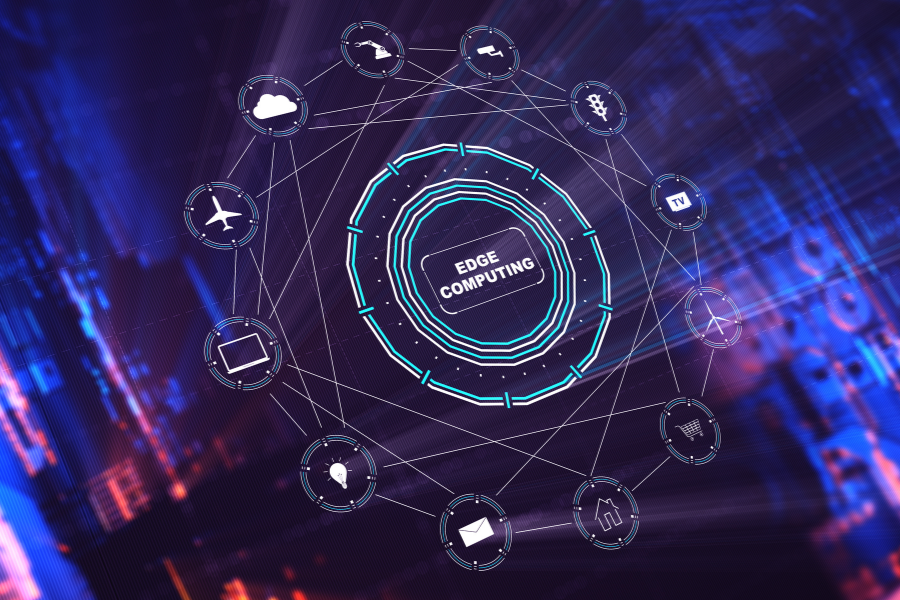HOT OFFER! Save $180 on selected internet plans + get beIN SPORTS CONNECT included!...Use promo code BEIN30 at checkout! Hurry, limited time only!
What is Edge Computing, and How Will it Transform the Future?
Home & Business Internet Blog | MATE | 27 March 2024

Every day, we seem to be seeing new and exciting advances in technology. Edge computing is an up-and-coming technology that can help to manage how large amounts of data are processed and managed. While this might not sound too interesting at first, the potential uses for edge computing and the transformative new technologies it can facilitate offer plenty of things to get excited about.
What is edge computing and why does it matter?
What is edge computing? Edge computing is a way of managing computer data that takes care of calculations and storing information nearer to where it’s actually needed, rather than relying on far-off data centres like traditional cloud computing does.
This shift towards edge computing is about moving away from storing everything in one centralised place. Why? Because bringing the process closer to home tackles some of the drawbacks of relying solely on cloud computing, such as delays in data transmission (latency) and the amount of data that can be sent over a network (bandwidth use). This makes the whole process of handling data more efficient and smoother. This shift is highly relevant in today’s digital age, where smart devices are everywhere, and the Internet of Things (IoT) is generating huge amounts of data every second of the day.
How edge computing works: The basics
Edge computing works by spreading out data processing and operating through dedicated servers known as ‘edge servers’. They store data closer to its original creation point rather than send it across long distances to a centralised data centre or to the cloud allowing businesses to access their data in a much faster and more efficient way.
Edge computing enables businesses and services to process data closer to its source (that is, at the network edge) rather than sending it across large distances to a centralised data centre. This proximity to data sources not only speeds up the processing time but also reduces the risk of data congestion and potential breaches, making edge computing an important foundation for modern digital infrastructure.
This method is based on a distributed computing framework, which means that the computing power is scattered across different places, from factories to city infrastructure. This setup makes handling data quicker and more efficient, as it can respond immediately to the needs of each location.
The benefits of edge computing
By bringing computing closer to the data source, edge computing addresses many challenges posed by traditional cloud computing models. The benefits of edge computing include:
- Reduced latency: Processing data near its source drastically cuts down on delay, enabling real-time responses critical for applications like autonomous vehicles and smart city technologies.
- Increased efficiency: By minimising the distance data travels, edge computing helps by reducing bandwidth usage and accelerates data analysis, leading to more efficient operations.
- Enhanced security: Local data processing limits the exposure of sensitive information, reducing the risk of data breaches and ensuring better compliance with privacy regulations.
- Reliability: Edge computing provides consistent service even in areas with poor connectivity, ensuring that essential functions are maintained without interruption.
- Scalability: Businesses can scale their operations more effectively, adding edge computing resources as needed without overhauling their entire IT infrastructure.
- Improved customer experience: Real-time processing capabilities allow for more personalised and timely interactions, enhancing the overall customer experience.
Edge computing vs. cloud computing
While edge computing and cloud computing may seem like competing technologies, they actually complement each other. Cloud computing offers powerful, scalable resources for heavy-duty data processing and storage, making it ideal for tasks that are not time-sensitive or do not require immediate local processing. On the other hand, edge computing excels in scenarios where low latency and local data processing are paramount, such as in autonomous driving systems or real-time health monitoring.
The relationship between edge computing and cloud computing enables a more flexible, efficient and secure digital ecosystem. Businesses can achieve optimal performance by capitalising on the strengths of both: cloud computing can be used for comprehensive analytics and data storage, while using edge computing for immediate, localised data processing. Combining these two technologies means that data is handled in the most efficient way possible.
Why is edge computing important for modern technology?
So we’ve already mentioned that edge computing is a critical enabler for next-gen technologies such as smart cities and autonomous vehicles. But how exactly will it shape the future and how we interact with our smart devices?

Enhancing the capabilities of smart devices
By processing data closer to where it’s generated, edge computing allows for real-time data analysis and decision-making without the latency associated with data transit to distant servers. This immediacy is important for applications that require instant responses—such as autonomous vehicles, which must make split-second decisions to ensure safety on the roads.
When smart devices use edge computing, they can offer much smarter and more personalised experiences. For instance, wearable health trackers can check your health in real time and give you instant updates on how you’re doing or warn you if there might be a health problem.
Strengthening network resilience and reliability
Another way in which edge computing is vital for modern technology is its ability to enhance network resilience and reliability. By decentralising data processing and storage, edge computing reduces the dependency on a central data centre. This means that if one part of the network experiences a failure or a cyberattack, the entire system is not compromised.
This decentralisation ensures that critical services and applications can continue to operate even in the face of localised disruptions. This is essential for the future of smart cities—even if one edge device fails, others can still continue to manage the flow of traffic, energy distribution and emergency services without disruption.
In addition to this, the distribution of data processing to edge devices can help manage network congestion. By handling data locally, less information needs to be sent back and forth over the network, easing the load on bandwidth and improving overall network performance.
The role of mobile edge computing in modern technology
Mobile edge computing (MEC) is a great example of how important edge computing is, especially when it comes to making mobile internet faster and more reliable. MEC moves computing power closer to where people are using their mobile phones. This improves the quality of mobile services people receive, especially in busy places like cities or large events where lots of people are trying to use the internet at the same time.
MEC also makes it possible for mobile apps to do new and exciting things. For example, augmented reality (AR) and virtual reality (VR) apps, which let you see digital images as if they were in the real world or take you into completely virtual worlds, work a lot better with MEC. This is because these kinds of apps need a lot of data quickly to give users the best experience. MEC can help with this by reducing latency, making AR and VR more seamless and fun, as well as benefiting any other kind of apps that use a lot of data.
How edge computing is revolutionising industries
Edge computing has benefits beyond smart devices and mobile services. It also gives businesses the speed and security they need to succeed in a world where technology is constantly evolving at an increasingly rapid rate. Here’s just some of the ways in which edge computing services can help to shape the future for businesses in Australia.
Increased speed and efficiency
One of the most significant advantages of edge computing for businesses is the dramatic improvement in operational efficiency. By processing data at the edge, closer to where it’s generated, businesses can significantly reduce latency.
This can lead to faster decision-making and more agile responses to market changes. This speed is particularly crucial in sectors like manufacturing, where edge computing can streamline operations by instantly analysing and acting upon data from sensors on the production line, resulting in reduced downtime and increased productivity.
Enhanced security
Edge computing makes data safer and more secure. By handling data right where it’s collected instead of sending it off to big data centres, there’s less chance of this data being intercepted, stolen or illegally viewed by the wrong people. This is especially important for organisations like hospitals or banks, where keeping patient data and customer information safe is a top priority.
Improved scalability and flexibility
By decentralising data processing and bringing it closer to the source, businesses can easily scale their computing resources up or down based on current demand without overhauling their entire IT infrastructure.
This flexibility allows businesses to efficiently manage their resources, adapting quickly to fluctuations in data volume or processing needs. For example, retail companies can use edge computing to manage peak shopping periods by processing customer data and inventory information in real time, ensuring they can meet customer demand without delay. This adaptability is essential for businesses looking to stay competitive in dynamic, ever-evolving market conditions.

Edge computing solutions for the future
By making our devices, wearables, vehicles and cities smarter, edge computing is set to revolutionise how we interact with the world around us.
Smart cities
You’ve probably heard a lot about ‘smart cities’ recently. But what exactly makes a city smart? Essentially, the idea behind smart cities is that they utilise a web of interconnected technologies to improve the quality of life for their residents. Edge computing’s ability to process vast amounts of data quickly and locally is key to the success of these systems, allowing for instant adjustments based on current traffic conditions.
Here are just a few examples of what life in a smart city could look like in the future, facilitated by edge computing technology:
- Smart waste collection: Bins equipped with sensors that monitor waste levels in real time can help to create a cleaner and more eco-friendly city. These bins can notify collection services when they are nearing full capacity, optimising collection routes and schedules. This not only ensures a cleaner urban environment but also reduces the carbon footprint by preventing unnecessary collection trips.
- Smart traffic management: Smart traffic management systems use a network of sensors and cameras to monitor traffic flow and conditions in real time. By processing this data on the spot with edge computing, these systems can dynamically adjust traffic lights, reduce congestion, and inform drivers of optimal routes. They could even redirect traffic if there is an accident or a delay. This leads to significant reductions in travel time and emissions, while also enhancing road safety.
- Smart energy management: Cities can optimise energy consumption in buildings and across the grid, using sensors and real-time data analytics to adjust power usage dynamically. This could mean lower utility bills for residents and businesses, and a significant step towards sustainability by reducing the city’s carbon footprint.
- Smart drones: Drones equipped with cameras and sensors could perform a variety of tasks, from monitoring traffic and crowd densities to inspecting infrastructure like bridges and buildings for maintenance needs. By processing data locally through edge computing, these drones can make quick decisions, such as identifying the fastest routes to their destinations or instantly alerting emergency services to accidents or hazards.
Self-driving cars
Autonomous vehicles, or self-driving cars, are set to redefine the future of transportation. By using sensors and advanced algorithms to navigate roads without human input, these cars promise to decrease accidents caused by human error, reduce traffic congestion, and provide mobility for those unable to drive. Edge computing is key to their development, as it allows for the rapid processing of huge amounts of data from the vehicle’s sensors, enabling real-time decision-making that is critical for safety and efficiency. This technology ensures that autonomous vehicles can respond immediately to changing road conditions, from avoiding obstacles to adapting to sudden weather changes.
Wearable technology
Edge computing is also transforming healthcare by enabling more sophisticated wearable technologies. These devices monitor health metrics in real time, from heart rate and blood sugar levels to oxygen saturation, providing critical data directly to healthcare providers. This immediate processing capability allows for early detection of potential health issues, personalised healthcare plans, and even emergency alerts in critical situations. For patients with chronic conditions, this can mean faster and more effective responses to health concerns.
What’s next for edge computing?
Edge computing, supported by the future 6G network, has the potential to unlock an almost limitless amount of technological advancements we can only just begin to comprehend. With new advances in technology emerging all the time, the future looks exciting indeed.
At MATE, we’re passionate about emerging technologies and how they can facilitate new developments in our world that can contribute to sustainability, accessibility and overall efficiency. For more technology articles and how these new advances can and will shape our lives, make sure you watch this space and check out our latest blog articles for more articles on the latest tech trends.

